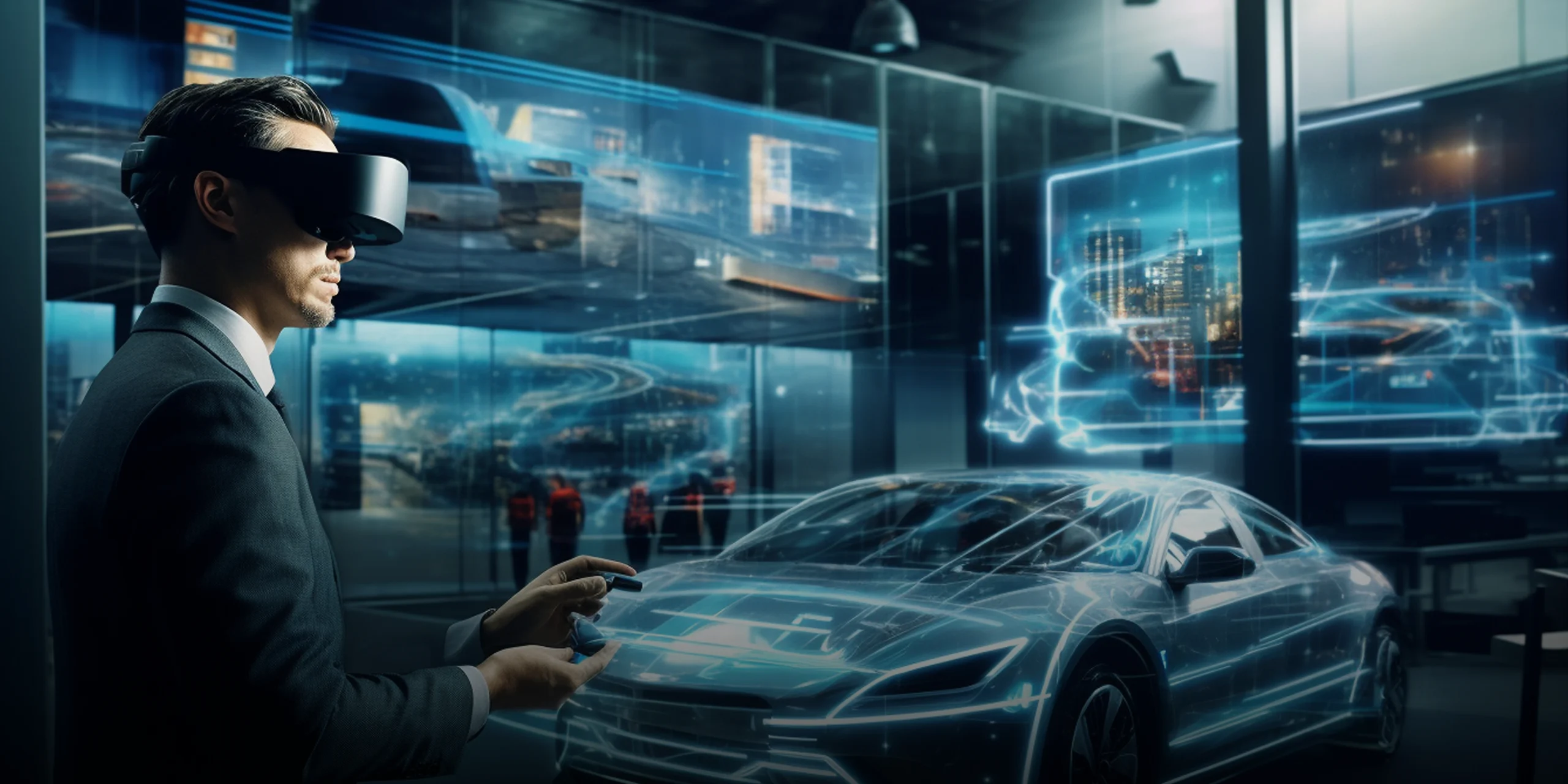April 29th, 2025
Category: virtual reality
No Comments
Posted by: Team TA

Virtual reality is transforming the automotive industry, impacting everything from design and engineering to marketing and training. Major manufacturers like BMW, Mazda, and Lamborghini are leveraging VR for diverse applications, recognizing its potential as a key Industry 4.0 technology. With the automotive VR market projected to rise from $1.88 billion in 2023 to $11.12 billion by 2032 (MRFR), its impact is undeniable.
This rapid adoption reflects VR’s versatility in creating virtual showrooms, training both experienced and inexperienced drivers, and simulating extreme testing conditions. This article examines how virtual reality is transforming automotive development, testing, and marketing.
1. VR for Vehicle Prototyping
Virtual reality simplifies automotive prototyping by replacing bulky physical models with virtual designs. Designers can manipulate 3D virtual prototypes, quickly adjusting them based on safety, design, or stakeholder feedback, streamlining the entire process.
This speeds up research and development, reduces adjustment rounds, and drastically lowers costs in the pre-manufacturing phase. By allowing designers to visualize, test, and modify full-scale 3D models, VR ensures faster, more efficient prototyping, minimizing waste and improving innovation in vehicle design.
2. Virtual Reality Showrooms
Virtual reality is transforming car shopping with immersive virtual showrooms. Instead of visiting dealerships with limited stock, buyers can explore and customize any model in a VR environment. They can walk around the car, sit in the driver’s seat, and even experience virtual test drives.
VR is being used by well-known companies like Audi and Toyota to promote upcoming models and improve consumer interaction. By allowing customers to view and customize cars from any location, this technology increases online sales.
3. Advancing Driver Training and Road Safety
VR training is improving automotive education, from manufacturing to after-sales. It provides a risk-free environment for technicians to practice repairs and maintenance on virtual models, preparing them for real-world scenarios. Additionally, VR makes CKD assembly instruction and safety exercises more accurate and efficient. VR driving lessons are also advantageous to car buyers, particularly for autonomous vehicles, as they increase safety and familiarity before purchase.
According to PWC, VR training is four times more successful than conventional techniques. Its immersive nature allows trainees to develop crucial muscle memory in a simulated environment. This enhances knowledge retention and accelerates skill development for both professionals and potential car buyers.
4. Immersive Entertainment & Media
VR transforms automotive entertainment and media by creating immersive experiences like virtual car shows and test drives. Customers can explore models and features in engaging virtual environments, enhanced by tangible feedback from gadgets like hexapods. This interactive approach captivates audiences and boosts conversion rates by creating memorable customer interactions.
5. Art & Culture: Immersive Brand Storytelling
Virtual reality enables brands to create immersive virtual car museums and exhibitions, allowing a global audience to explore automotive history and classic models. Global audiences can learn about classic cars and automotive history through interactive experiences. Customer engagement, brand loyalty, and brand connection are all enhanced by this captivating storytelling.
6. After-sales Opportunities – Virtual Driving Experiences
VR is being used by automakers to provide customers with immersive driving experiences in harsh environments, such as dunes or snowy highways. Before going on adventures in the real world, this virtual training increases excitement and confidence. By providing realistic previews, brands strengthen customer relationships and create new after-sales opportunities, turning virtual experiences into valuable engagement and revenue channels.
7. Testing and Evaluating New Technologies
VR enhances automotive technology testing. It allows cost-effective, scalable testing of driver-assistance and autonomous features in safe, virtual environments, improving their reliability. VR also enhances virtual test drives, offering realistic simulations of vehicle performance and safety features, improving customer understanding and engagement.
VR Application Examples
1. Audi
Audi pioneered VR in automotive sales, introducing over 400 customer-private lounges with VR stations. Customers can view all models and features of their configured cars in breathtaking 4K detail in these lounges. VR became a potent sales and engagement tool for Audi because of this immersive experience, which increased customer confidence and expedited the purchasing process.
2. BMW
BMW integrated VR into retail with VR@Retail, allowing customers to explore and customize vehicles in an immersive environment. At premiere events like the M Drive Tour Virtual Experience, users configured BMW M models online and drove a virtual lap on Le Mans, enhancing engagement and personalization in the car-buying experience.
3. Toyota
Toyota created realistic VR experiences in European shopping centers to market the C-HR model. Customers easily customized and interacted with a life-sized virtual automobile in virtual reality. This innovative approach deepened engagement, allowing users to experience the vehicle’s design and features interactively and memorably.
On a Final Note,
Virtual reality is transforming the automotive industry by enhancing customer engagement, training, and innovation. From realistic virtual showrooms to immersive test drives, VR is redefining experiences and setting new industry standards. As VR evolves, its potential across the customer journey will expand.
Eager to leverage VR for your automotive business?
Travancore Analytics is your ideal partner. Our team combines deep automotive industry expertise with cutting-edge VR development skills to create custom applications tailored to your specific needs.